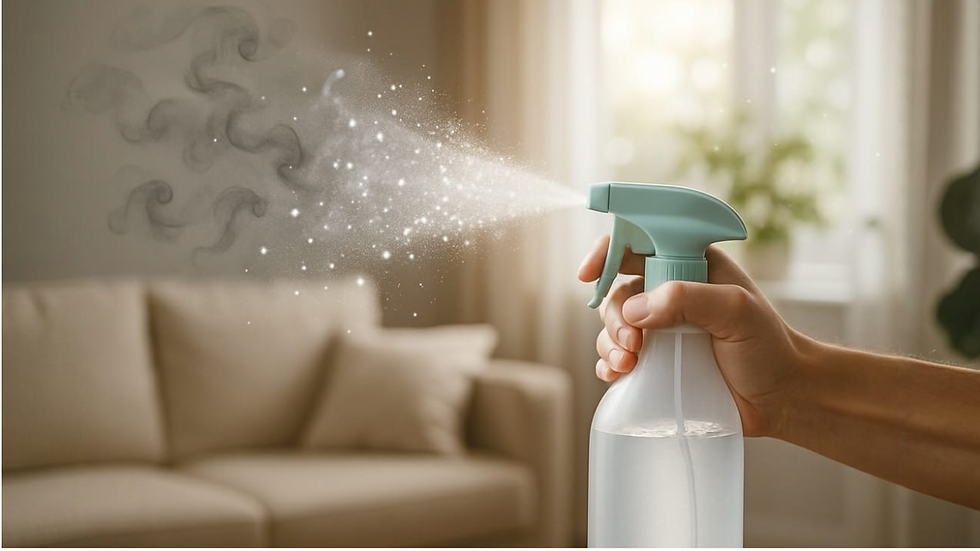Odor Removal After Decomposition: Proven Techniques That Actually Work
- HazardPros

- Aug 11
- 4 min read

Decomposition odors are among the most challenging problems in residential restoration. They’re stubborn, protein-based, and capable of migrating into porous materials, wall cavities, and HVAC systems. Good news: with the right sequence—source removal, deep cleaning, neutralization, and sealing—you can restore a space to livability. This article explains how pros approach the job, where homeowners can safely help, and where to draw the line.
Why decomposition odor is different
Decomposition releases a complex mix of volatile organic compounds (VOCs), amines (like putrescine and cadaverine), sulfur compounds, and fatty acids. These molecules bind aggressively to porous substrates and can continue off-gassing even after visible contamination is gone. That’s why “just airing it out” rarely works.
The professional sequence (and why order matters)
Source discovery and removalEven a teaspoon of overlooked material will keep an entire room odorous. Technicians methodically open layers (e.g., carpet → pad → tack strips) and inspect baseboards, subfloor seams, furniture frames, and under-appliance voids. Anything porous that’s saturated gets removed and bagged for disposal.
Detail clean: top-down, clean-to-dirty
Nonporous surfaces: detergent clean first, then disinfect.
Semi-porous: controlled abrasion or alkaline cleaners loosen residues.
Hidden pathways: electrical outlets, floor vents, and weep holes are checked to stop odor migration.
Neutralization (choose your chemistry wisely)
Enzymatic/oxidative odor neutralizers break down odor molecules.
Hydroxyl generators (not to be confused with ozone) can help during work phases because they’re safe to operate in occupied spaces when used properly.
Ozone is potent but risky: it can damage rubber and textiles and poses respiratory hazards. The U.S. Environmental Protection Agency cautions that ozone generators marketed for home air cleaning can be ineffective and harmful if misused; consider them specialty tools for unoccupied, controlled conditions only, not first-line solutions.
Sealing and encapsulation After cleaning and neutralization, pros apply odor-blocking sealers to subfloors, joists, and other structural members. This doesn’t replace cleaning; it locks in any trace residues and evens out porous surfaces so new finishes won’t re-release odor.
HVAC assessment If the system was running, ducts may carry odor into other rooms. Options include: filter upgrades, coil cleaning, duct sealing/cleaning, and temporary system shutdown during remediation. Air cleaning technologies can help, but choose evidence-based solutions and be wary of marketing claims. The EPA’s homeowner guide to air cleaners is a useful plain-language overview of what different technologies can and can’t do.
Where homeowners can help (and where not to)

Helpful tasks:
Increase ventilation during daytime work (open windows/doors when safe).
Remove unaffected textiles for laundering; seal them in bags during transport.
Run standalone HEPA air purifiers in adjacent rooms to reduce cross-contamination.
Avoid:
Spraying strong fragrances to “cover” odors—this masks, doesn’t fix, and can complicate assessment.
Saturating subfloors with bleach; it’s corrosive, can off-gas, and doesn’t penetrate deeply.
DIY ozone bombs; they can degrade materials and pose health risks.
Materials triage: what stays, what goes
Hard, nonporous (tile, sealed stone, metal): Usually restorable with thorough cleaning and targeted sealing at seams.
Semi-porous (finished wood, painted drywall): Often restorable; may need sanding and encapsulating primer.
Porous (carpet, pad, raw wood, unsealed concrete, upholstery): If saturated, removal is the faster, more certain path. Concrete can sometimes be decontaminated with alkaline cleaners and then sealed.
Odor testing and confirmation
Pros rely on a mix of sensory checks and instruments (e.g., PID sniffers, ATP swabs for cleanliness). The goal is not just “smells better” but no detectable odor after the space has been closed up for 24–48 hours. Documented before/after photos, disposal logs, and product data sheets create a transparent record for insurers and future buyers.
Common pitfalls that prolong odor
Skipping source removal. Foggers alone won’t solve a hidden reservoir.
Treating HVAC last. Odor can loop through returns and supply lines.
Partial demolition. Leaving a contaminated baseboard or tack strip can re-seed odor.
Rushing paint. Seal, then paint—don’t rely on standard primers to block odor.
Health and safety during the work
Keep the work zone controlled: closed doors, taped thresholds, negative air if needed.
Wear appropriate PPE (gloves, eye protection, respirator if aerosolizing).
Bag and label removed materials; store away from living areas until disposal.
Maintain ventilation during chemical applications and adhere strictly to product instructions.
Timelines and expectations
With decisive action, most single-room cases can be resolved in days, not weeks. Multi-room or long-undiscovered events take longer due to demolition, drying, and sequencing across trades. The benchmark for “done” is simple: clean structure, no detectable odor, HVAC cleared, contents addressed, and the space comfortable for extended occupancy.
Insurance and documentation notes
Homeowners insurance may cover remediation when the cause of loss is covered (e.g., certain sudden events). Claims for decomposition after an unattended natural death vary by policy. Strong documentation—scope of work, product lists, disposal receipts, and photo logs—supports claim review and future disclosure needs.
The emotional dimension
Technical success matters, but so does emotional safety. A good remediation plan respects privacy, uses unmarked vehicles when possible, and sequences work to minimize distressing visuals for family members. Finishing touches—new flooring, fresh paint, re-hung photos—help the home feel like home again, not a scene to “get past.”
Need a clear, step-by-step plan to eliminate decomposition odors for good? Start a discreet conversation by contacting us here. We’ll help you chart the fastest path back to a clean, livable space.




Comments